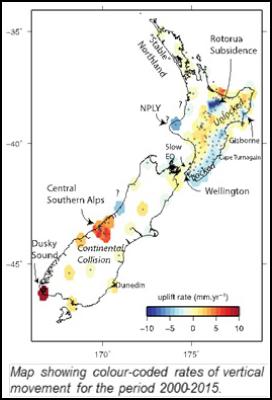Satellite observations provide new insight into sea levels
23 November 2016
Satellite observations provide new
insight into sea level rise

Parts of New Zealand are sinking at faster rates than others and will be subjected to higher levels of future sea level rise, new research from Victoria University of Wellington suggests.
The just-published tectonic research provides new information about how different parts of New Zealand are either rising or subsiding in relation to the centre of the earth.
Data were collected by Geonet’s GPS recorders between 2000 and 2015, and the first map has been produced of relative vertical movements of the Earth’s surface based on measurements at 189 locations across the country.
Analysis of the data shows that parts of New Zealand, like the North Island’s east coast, have subsided at rates as high as three millimetres per year for the past 15 years.
This means this region is effectively subjected to a maximum sea level rise of up to six millimetres per year, which is twice the global average.
Co-author Professor Tim Stern from Victoria’s School of Geography, Environment and Earth Sciences says other parts of New Zealand are rising.
“For example, along parts of the Bay of Plenty coast, the Whanganui coast and south to the Kapiti region, and along the Otago, Westland and Southland coastlines, there are small rises of one millimetre per year or less. This means that sea level rise in these areas will be less than the global average.
“The data also show inland areas of the South Island and the Southern Alps are rising by up to six millimetres per year, while in the Rotorua area there is a remarkable subsidence rate of 15 millimetres per year. Most of these areas of subsidence and uplift can be explained through our knowledge of plate tectonic processes occurring in New Zealand.”
Professor Stern says the research is a good start to understanding New Zealands’s exposure to sea level rise.
“It is well accepted that global warming is a major factor causing present-day global sea levels to be rising by two to three millimetres a year. What’s less known, however, is that in some places, such as New Zealand, tectonic processes can locally add to the land subsidence, whereas elsewhere they act to negate it.
“This new information should be a key input into planning to mitigate coastal erosion and to enhance our resilience to sea level change. In five to ten years, we will have even more information from the GPS technology to add to this knowledge.”
The research, co-authored by Professor Stern and Dr Nicolas Houlié from ETH-Zurich, Switzerland, has recently been published online in Earth and Planetary Science Letters.
Professor Stern says last weeks earthquake and uplift of the Kaikoura-Cape Campbell region is a reminder that that earthquake events can suddenly reverse the decades-long subsidence seen in parts of eastern North Island.
ends


 Business Canterbury: Urges Council To Cut Costs, Not Ambition For City
Business Canterbury: Urges Council To Cut Costs, Not Ambition For City Wellington Airport: On Track For Net Zero Emissions By 2028
Wellington Airport: On Track For Net Zero Emissions By 2028 Landcare Research: ANZAC Gall Fly Release Promises Natural Solution To Weed Threat
Landcare Research: ANZAC Gall Fly Release Promises Natural Solution To Weed Threat NZ Anti-Vivisection Society: Auckland Rat Lovers Unite!
NZ Anti-Vivisection Society: Auckland Rat Lovers Unite! University of Canterbury: $1.35 Million Grant To Study Lion-like Jumping Spiders
University of Canterbury: $1.35 Million Grant To Study Lion-like Jumping Spiders Federated Farmers: Government Ends War On Farming
Federated Farmers: Government Ends War On Farming



